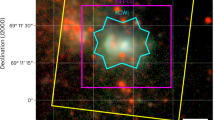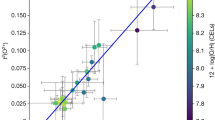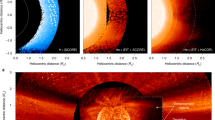Abstract
WE report here a search for the He109α line from the galactic centre HII region G0.5-0.0. Our failure to detect the line sets an upper limit to the abundance of helium which is about 10% of the abundance found in many HII regions. Our limit of 0.01 for the abundance of helium relative to hydrogen is even lower than the limits of 0.021 and 0.025 recently reported1 for two other galactic centre regions, G0.7-0.0 (Sgr B2) and G0.2-0.0.
This is a preview of subscription content, access via your institution
Access options
Subscribe to this journal
Receive 51 print issues and online access
$199.00 per year
only $3.90 per issue
Buy this article
- Purchase on Springer Link
- Instant access to full article PDF
Prices may be subject to local taxes which are calculated during checkout
Similar content being viewed by others
References
Mezger, P. G., and Churchwell, E. B., Nature, 242, 319 (1973).
Batchelor, R. A., Brooks, J. W., and Sinclair, M. W., Proc. IREE Austral., 30, 39 (1969).
Mezger, P. G., Wilson, T. L., Gardner, F. F., and Milne, D. K., Astrophys. Lett., 6, 35 (1970).
Palmer, P., Zuckerman, B., Penfield, H., Lilley, A. E., and Mezger, P. G., Astrophys. J., 156, 887 (1969).
Rubin, R. H., Astrophys. J., 74, 994 (1969).
Menon, T. K., Astrophys. J., 136, 95 (1962).
Rubin, R. H., Astrophys. J., 153, 761 (1968).
Osterbrock, D. E., and Flather, E., Astrophys. J., 129, 26 (1969).
Penston, M. V., Mon. Not. Roy. Astron. Soc., 144, 159 (1969).
Peimbert, M., and Costero, R., Bol. Obs. Tonanzintla Tacubaya, 5, 3 (1969).
Churchwell, E. G., and Mezger, P. G., Astrophys. Lett. 5, 227 (1970).
Martin, A. H. M., and Downes, D., Astrophys. Lett., 11, 219 (1972).
Greenstein, J., Astrophys. J., 144, 496 (1966).
Sargent, W. L. W., and Searle, L., Astrophys. J., 145, 652 (1966).
Hoyle, F., and Taylor, R. J., Nature, 203, 1108 (1964).
Burbidge, G. R., and Burbidge, M. E., Comm. Astrophys. Space Phys., 2, 92 (1970).
Peebles, P. J. E., Phys. Rev. Lett., 16, 410 (1966a).
Peebles, P. J. E., Astrophys. J., 146, 542 (1966b).
Wagoner, R. V., Fowler, W. A., and Hoyle, F., Science, 152, 677 (1966).
Wagoner, R. V., Fowler, W. A., and Hoyle, F., Astrophys. J., 148, 3 (1967).
Hawking, S. W., and Taylor, R. J., Nature, 209, 1228 (1966).
Author information
Authors and Affiliations
Rights and permissions
About this article
Cite this article
HUCHTMEIER, W., BATCHELOR, R. Anomalous Helium Abundance of the Galactic Centre HII Region G0.5-0.0. Nature 243, 155–156 (1973). https://doi.org/10.1038/243155a0
Received:
Issue Date:
DOI: https://doi.org/10.1038/243155a0
This article is cited by
-
A galactic model with a pulsating active nucleus
Astrophysics and Space Science (1974)
Comments
By submitting a comment you agree to abide by our Terms and Community Guidelines. If you find something abusive or that does not comply with our terms or guidelines please flag it as inappropriate.



